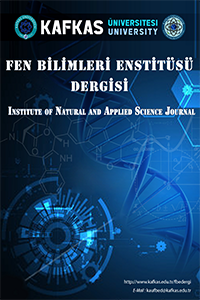Bakır(II) 4-Klorofenilasetat İzonikotinamid Kompleksinin Sentezi, Spektroskopik, Termik ve Floresans Özellikleri
Bu çalışmada [Cu(4-Cl-phenac)2(ina)2] genel formüllü (4-Cl-phenac=4-klorofenilasetat; ina=izonikotinamid) kompleks sentezlenmiştir. Kompleksin yapısını aydınlatmak için elementel analiz, FT-IR spektroskopisi yöntemleri kullanılmış ve kompleksin termal kararlılığı TGA/DTA analizi ile incelenmiştir. Kompleksin optik özellikleri ve floresans davranışları UV-Vis and Floresans Spektroskopisi yöntemleri ile incelenmiştir. Bakır atomları çevresinde karboksilat oksijen atomları üzerinden koordine olan 4-klorofenilasetik asit anyonları ve piridin halkasında bulunan azot atomu üzerinden koordine olan izonikotinamid ligandları ile hafif bozulmuş tetrahedral geometri oluşmaktadır. Susuz kompleks yaklaşık 200°C’den itibaren bozunmaya başlamaktadır. Organik ligandların da yapıdan parçalanarak uzaklaşması neticesinde komplekslerden geriye CuO kaldığı belirlenmiştir. Kompleks 225 nm dalga boyunda uyarıldığında yaklaşık 350 – 475 nm arasındaki bölgede ışıma yaptığı gözlemlenmiştir.
Anahtar Kelimeler:
Bakır kompleksi, 4-Klorofenilasetik asit, İzonikotinamid, Spektroskopi, Optik Özellikler
Synthesis, Spectroscopic, Thermal and Fluorescence Properties of Copper (II) 4-Chlorophenylacetate with Isonicotinamide
In this study, the complex of [Cu(4-Cl-phenac)2(ina)2] (4-Cl-phenac = 4 chlorophenylacetate; ina = isonicotinamide) with general formula was synthesized. Elemental analysis and FT-IR spectroscopy methods were used to determine the structure of the complex and thermal stability of the complex was examined by TGA/DTA analysis. Optical properties and fluorescence behavior of the complex were investigated by UV-Vis and Fluorescence Spectroscopy. In these complexes copper ions possess an tetrahedral geometry with two oxygen atoms of 4-chlorophenylacetate anions, two nitrogen atoms from two isonicotinamide. The anhydrous complex beganto decompose at about 200 °C. As a result of the remove of organic ligands from the structure, CuO was a final product of thermal decomposition. The anhydrous complex began to decompose at about 200 °C. When the complex was excited at a wavelength of 225 nm, the emission peaks were observed between 350-475 nm.
Keywords:
Cu complex 4-chlorophenylacetatic acid, Isonicotinamide, Spectroscopy, Optical properties, Fluorescence,
___
- Ahuja I.S. and Prasad I. (1976) Isonicotinamide complexes with some metal(II) halides and pseudohalides, Inorganic and Nuclear Chemistry Letters, 12(10), 777–784.
- Chakrabarty P.P., Biswas D., García-Granda S.,. Jana A.D, Saha S. (2012) Sodium ion assisted molecular self-assembly in a class of Schiff-base copper(II) complexes. Polyhedron, 35(1), 108–115.
- Deacon G., (1980) Relationships between the carbon-oxygen stretching frequencies of carboxylato complexes and the type of carboxylate coordination. Coordination Chemistry Reviews, 33(3), 227–250
- Desmonts L. B., Reinhoudlt D.N., Mercedes C.C. (2007) Design of fluorescent materials for chemical sensing, Chemical Society Reviews, 36, 993 – 1017.
- Hökelek T., Dal H., Tercan B., Özbek F.E., Necefoğlu H. (2009) Tetraaquabis(nicotinamide-κ N 1 )nickel(II) bis(2-fluorobenzoate). Acta Crystallographica Section E Structure Reports Online, 65 (1), m1330–m1331.
- Homzová K., Györyová K., Koman M., Melník M., Juhászová Ž. (2015) Synthesis, crystal structure, and spectroscopic and thermal properties of the polymeric compound catena -poly[[bis(2,4-dichlorobenzoato)zinc(II)]-μ-isonicotinamide]. Acta Crystallographica Section C Structural Chemistry, 71 (9) 814–819.
- Huang X., Sun H., Dou J., Li D., Wang D. Liu G. (2007) A dimeric luminescent lanthanide complex [Eu(PAA) 2 (phen)(NO3)]2 : hydrothermal synthesis, crystal structure and fluorescence. Journal of Coordination Chemistry, 60 (19), 2045–2050.
- Iqbal M., Ahmad I., Ali S., Muhammad N., Ahmed S., Sohail M. (2013) Dimeric “paddle-wheel” carboxylates of copper(II): Synthesis, crystal structure and electrochemical studies. Polyhedron, 50 (1), 524–531.
- Iqbal M., Ali S., Tahir M.N., Shah N.A., (2017), Dihydroxo-bridged dimeric Cu(II) system containing sandwiched non-coordinating phenylacetate anion: Crystal structure, spectroscopic, anti-bacterial, anti-fungal and DNA-binding studies of [(phen)(H 2 O)Cu(OH) 2 Cu(H 2 O)(phen)]2L.6H 2 O: (HL = phenylacetic acid; phen = 1,10-phenanthroline). Journal of Molecular Structure, 1143, 23–30.
- Lakowicz J. R., (2006). Principles of fluorescence spectroscopy, 3rded. Springer, New York, 530 – 566.
- Mandal A., Patel B.K., (2017) Molecular structure and fluorescence property of Zn(II), Cd(II) complexes of 3-pyridyl-5-aryl-(1H)-1,2,4-triazoles. Polyhedron, 132, 112-122.
- Nakamoto K. (2008) Infrared and Raman Spectra of Inorganic and Coordination Compounds: Hoboken, NJ, USA, John Wiley & Sons, Inc., doi:10.1002/9780470405840.
- Pavia D. L., Lampman G.M., Kriz G.S. (2001) Introduction to spectroscopy: a guide for students of organic chemistry: South Melbourne, Brooks/Cole.
- Sheng, G.H., Cheng X-S., You Z.L, Zhu H.L. (2015) Syntheses, Crystal Structures, and Characterization of Copper(II) and Zinc(II) Complexes Derived from N,N-Dimethylethane-1,2-diamine and Phenylacetic Acid Derivatives. Synthesis and Reactivity in Inorganic, Metal-Organic, and Nano-Metal Chemistry, 45 (9) 1273–1277.
- Wen L., Yin H., Li W., Wang D. (2010) New organoantimony complexes with the isomers of chlorophenylacetic acid: Syntheses, characterizations and crystal structures of 1D polymeric chain, 2D network structure and 3D framework. Inorganica Chimica Acta, 363 (4), 676–684.
- Wu W.P., Wang J., Lu L., Wu Y. (2016) Syntheses and luminescence of four supramolecular coordination complexes with flexible ligand. Russian Journal of Coordination Chemistry, 42 (3),217–224.
- Yüksek M., Elmali A., Durmuş M., Yaglioglu H.G., Ünver H., Nyokong T. (2010) Good optical limiting performance of indium and gallium phthalocyanines in a solution and co-polymer host. Journal of Optics, 12 (1), 015208.
- Zhang, W.M., Li M.H, Sun J., Lv P.C, Zhu HL. (2014) Synthesis, characterization, and antibacterial evaluation of copper(II) complexes supported by phenylacetic acid derivatives, and diamine ligands. Journal of Coordination Chemistry, 67 (21) 3519–3531.
- ISSN: 2587-2389
- Yayın Aralığı: Yılda 2 Sayı
- Başlangıç: 2008
- Yayıncı: Kafkas Üniversitesi
Sayıdaki Diğer Makaleler
Mehmet Ali KIRPIK, Mustafa Kemal ALTUNOĞLU, Yağmur YILDIZ ASKER, Semra ALTUNKALEM
Canlılar Depremi Önceden Sezinleyebilir mi?
Cansen KADİRHAN, Mehmet Ali KIRPIK, Cem ÖZİÇ, Merve GÜLEN
Füreya Elif ÖZBEK, Mustafa SERTÇELİK, Mustafa YÜKSEK, Ali Murat TONBUL, Hacali NECEFOĞLU
Kars İli Arazileri ve Toprak Özelliklerinin Coğrafi Bilgi Sistemleri ile Değerlendirilmesi
